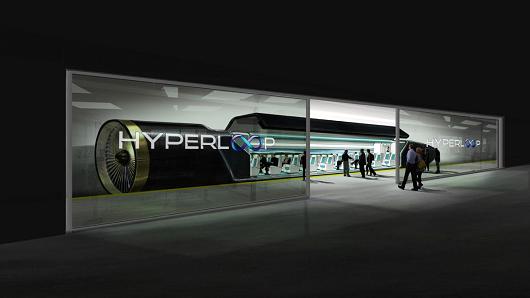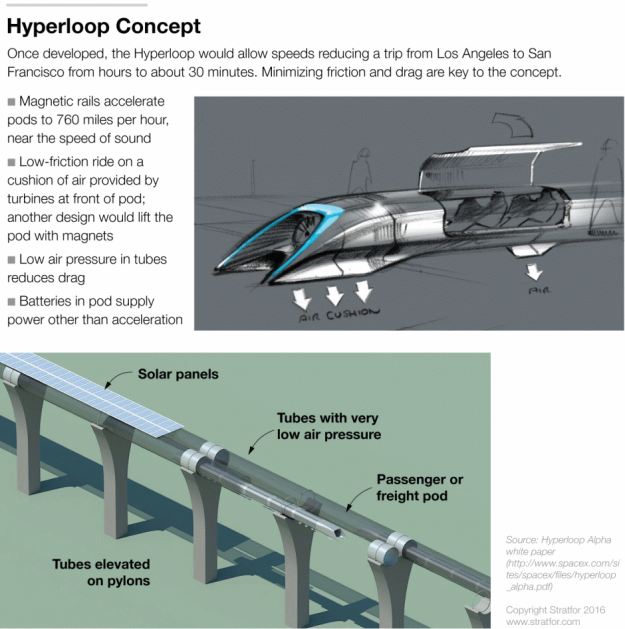https://fabiusmaximus.com/2016/10/01/the-hyperloop/
 Summary: History shows that the new industrial revolution just beginning will bring wonders, things often seemingly more like science fiction than practical technology. Here Stratfor looks at the hyperloop, a potentially transformative new transportation technology — if it works. At the end are links are posts about even more fantastic technologies.
Summary: History shows that the new industrial revolution just beginning will bring wonders, things often seemingly more like science fiction than practical technology. Here Stratfor looks at the hyperloop, a potentially transformative new transportation technology — if it works. At the end are links are posts about even more fantastic technologies.
 The combination of sailing ships and navigational gear such as the compass and the sextant revolutionized ocean transit, connecting the world in a way that had not been seen before. In the industrial age, trains linked continents and enabled the movement of large numbers of people and heavy goods overland. The widespread adoption of the automobile in the 20th century enabled freedom of movement for the individual. The airplane made the world smaller than ever before, enabling distances to be covered in hours rather than days or weeks. Comparatively smaller refinements in technology — such as container ships — increased efficiencies to the point where an unmistakable geopolitical impact occurred: the advent of globalization as we know it today.
The combination of sailing ships and navigational gear such as the compass and the sextant revolutionized ocean transit, connecting the world in a way that had not been seen before. In the industrial age, trains linked continents and enabled the movement of large numbers of people and heavy goods overland. The widespread adoption of the automobile in the 20th century enabled freedom of movement for the individual. The airplane made the world smaller than ever before, enabling distances to be covered in hours rather than days or weeks. Comparatively smaller refinements in technology — such as container ships — increased efficiencies to the point where an unmistakable geopolitical impact occurred: the advent of globalization as we know it today.
 Summary: History shows that the new industrial revolution just beginning will bring wonders, things often seemingly more like science fiction than practical technology. Here Stratfor looks at the hyperloop, a potentially transformative new transportation technology — if it works. At the end are links are posts about even more fantastic technologies.
Summary: History shows that the new industrial revolution just beginning will bring wonders, things often seemingly more like science fiction than practical technology. Here Stratfor looks at the hyperloop, a potentially transformative new transportation technology — if it works. At the end are links are posts about even more fantastic technologies.
Following a recent visit to Elon Musk’s Tesla electric car factory in California, Indian Prime Minister Narendra Modi expressed interest in a less mature but potentially more groundbreaking idea: Hyperloop. Musk, the founder of companies such as SpaceX and Tesla, released an open-source proposal for the new mode of transportation in 2013. Essentially a levitating train car traveling through a tube in near vacuum conditions, Hyperloop technology could make in minutes trips that normally take hours.
Over the past three years, a handful of companies have taken the idea and run with it. But despite interest and investment, enough physical and technical hurdles remain that implementation of such a system is years, possibly even decades, away. Should Hyperloop come to fruition, it has the potential to shape geopolitical relationships and behaviors of nations like other transportation methods that came before it. India’s prime minister is evidently optimistic about the technology, as are leaders from a number of other nations. But should they be?
 The combination of sailing ships and navigational gear such as the compass and the sextant revolutionized ocean transit, connecting the world in a way that had not been seen before. In the industrial age, trains linked continents and enabled the movement of large numbers of people and heavy goods overland. The widespread adoption of the automobile in the 20th century enabled freedom of movement for the individual. The airplane made the world smaller than ever before, enabling distances to be covered in hours rather than days or weeks. Comparatively smaller refinements in technology — such as container ships — increased efficiencies to the point where an unmistakable geopolitical impact occurred: the advent of globalization as we know it today.
The combination of sailing ships and navigational gear such as the compass and the sextant revolutionized ocean transit, connecting the world in a way that had not been seen before. In the industrial age, trains linked continents and enabled the movement of large numbers of people and heavy goods overland. The widespread adoption of the automobile in the 20th century enabled freedom of movement for the individual. The airplane made the world smaller than ever before, enabling distances to be covered in hours rather than days or weeks. Comparatively smaller refinements in technology — such as container ships — increased efficiencies to the point where an unmistakable geopolitical impact occurred: the advent of globalization as we know it today.
Hyperloop would not be the first technology to connect vast countries or sprawling continents. But if the full potential of the concept can be realized, it would do so faster than any current mode of transportation, save rocket launches and supersonic flight. And the Hyperloop system would theoretically be cheaper, cleaner and more energy efficient than conventional transport methods. In fact, the original proposal suggested that renewable power be used exclusively.
Though there are broad implications for everyday civilian users — Hyperloop could foreseeably enable commuters to live farther from urban centers, relieving traffic congestion in specific instances — the carrying of human passengers will likely be further off than using the technology to ferry freight. But express delivery is only one part of a broader issue. When it comes to moving goods, congestion all along the supply chain remains a serious problem, one that automation is increasingly trying to solve.
Inadequate or out-of-date infrastructure constrains the potential for future growth. Even in countries with advanced infrastructure, problems exist. In the United States, for example, aging water-based networks (the cheapest traditional method of transportation), choked rail networks and highway congestion in urban areas all can limit expansion. Public spending on infrastructure projects has traditionally been inadequate, and private companies are reticent to invest in or upgrade aging infrastructure.
As container ships continue to get larger, congestion and inefficiency at ports and rail hubs gets worse. Port automation will be vital to maintain the competitiveness of global distribution hubs. Automation will probably transform the global supply chain, but it will take time. Automation in manufacturing is increasingly commonplace, but it is the physical delivery of finished goods from supplier to exporter, from importer to distributor, and from distributor to door that creates congestion and slows the process. Independent of Hyperloop, automation projects that seek to move containers in and around port systems in an efficient manner are already progressing, along with automation in other parts of the supply chain.
Battle of the ‘Loops
At the core of Hyperloop’s futuristic proposal is the ability to minimize physical constraints, including friction and air resistance, that reduce speed and increase the energy input required to move people and things across distances. Instead of running on wheels, the theoretical Hyperloop pod would float (using either air or magnets) in a tube depressurized to near vacuum conditions, mimicking the minimal air resistance normally experienced at high altitudes. The envisaged system significantly reduces the amount of energy needed to propel the vessel forward.
As with any new technology, however, there are technical hurdles to overcome. Mastering the science of levitation, creating and maintaining a vacuum, and developing an effective propulsion system to move Hyperloop capsules are technical barriers that have yet to be truly broken. And then there is the matter of designing and fabricating a pod that will interact with an effective deceleration system; bringing a vessel to a steady halt from neck-breaking speeds without damaging onboard cargo.
One successful test in the Nevada desert showed that a Hyperloop vessel on wheels could be effectively accelerated, but the lack of brakes required the pod to be rammed into a pile of sand to come to a halt. Also, while there may eventually be potential for Hyperloop tubes to run underwater or underground to avoid complex terrain, the technology in early development is best suited for flat terrain to minimize external complicating factors. Still, even at this nascent stage of development, private companies and countries are announcing planned projects to implement Hyperloop once it is fully functional.
The open-source nature of the original proposal promotes cooperation but also leaves the door open for intense competition as well as smaller differences in technical execution as firms race to final production. Two main companies are competing to develop the technology: Hyperloop One(formerly known as Hyperloop Technologies) and Hyperloop Transportation Technologies(HTT), both headquartered in the United States. A third company based in Canada (Transpod Inc.) is also working to develop the technology, but the two U.S.-based companies have received the most publicity, had the most public demonstrations and signed the most cooperation deals around the world.
Though similar on paper, Hyperloop One and HTT are set up differently — the former has strong ties to Musk, while the latter basically operates on a “volunteer” basis with employees contributing time in exchange for stock options. Each has made significant announcements or advancements this year, including Hyperloop One’s successful desert test in the spring and HTT’s licensing of passive magnetic levitation — originally developed at Lawrence Livermore National Laboratories (LLNL) — called Inductrack. Active magnetic levitation is already used in high-speed rail transportation in Japan and China, but the passive nature of the LLNL method should significantly reduce energy input and cost.
Global Applications
Beyond the North American focus on Hyperloop, planned projects have been announced worldwide. HTT signed agreements with the government of Slovakia for materials development as well as future passenger lines between Vienna and Bratislava and Bratislava to Budapest. HTT is also working with a vacuum technology firm and recently announced a partnership with Deutsche Bank to improve the user experience in yet-to-be developed Hyperloop passenger cars. Hyperloop One is looking at potential passenger lines as well, but recent collaborations are more focused on the movement of goods.
One potential project — the movement of goods from Russia to China — has the support of Russian Railways. Still, given the larger scale and so many unknowns about the basic technology itself, uncertainties about cost and feasibility prevail. Projects with limited scope have a much higher potential to reach fruition. The recently announced partnership between global port operator DP World and Hyperloop One to eventually test the feasibility of the technology at Dubai’s busy Jebel Ali port is one such example. Other locations being studied for feasibility for a Hyperloop link are the ports of Los Angeles and Long Beach in California.
The concept of Hyperloop, should it be realized, has the potential to bring the public and private sectors together. It could increase efficiency in specific areas of the supply chain, potentially relieve congestion in urban areas and change the way people move between cities. The amount of time it takes, however, to develop a working Hyperloop system will be as important as its ultimate impact — it is certainly not the only technological solution to resolve existing constraints. The potential is there, though it is likely years or decades away. All that remains to be seen is whether those involved can actually make the technology work before interest and funding dry up.

No comments:
Post a Comment